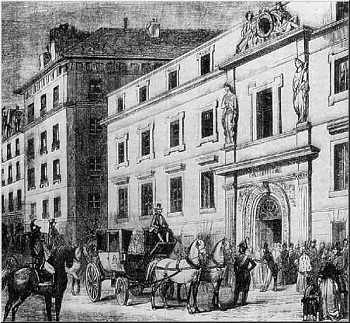Born: October 9, 1835; Paris, France
Died: December 16, 1921; Algiers,
Algeria
Nationality: French
Occupation: composer, organist, conductor,
pianist
Camille Saint-Saëns was a French composer, organist, conductor and pianist of the Romantic era, born on October 9, 1835 and died on December 16, 1921.
 |
| The rue du Jardinet, site of Saint-Saëns's birthplace |
His most
famous works include Introduction and Rondo Capriccioso, the Second Piano
Concerto, the First Cello Concerto, Danse macabre, the opera Samson and
Delilah, the Third Violin Concerto, the Third Symphony and The Carnival of the
Animals.
 |
| Samson and Dalila at the Paris Opéra (1892) |
Saint-Saëns, a musical prodigy, made his concert debut at the age of ten.
 |
| Saint-Saëns as a boy |
After studying at
the Paris Conservatoire, he began his career as a church organist, first at
Saint-Merri, Paris, and then from 1858, La Madeleine, the official church of
the French Empire.
 |
| The old Paris Conservatoire building, where Saint-Saëns studied |
As a young man, Saint-Saëns was enthusiastic for the most modern music of the day, especially that of Schumann, Liszt and Wagner, although his works generally belonged to a conventional classical music.
 |
| Robert Schumann |
Saint-Saëns, a scholar of musical history, devoted himself to the structures worked out by earlier French composers, resulting in conflict with composers of the impressionist and dodecaphonic schools of music in his later years.
 |
| Arnold Schoenberg, inventor of dodecaphony |
Although there were
neoclassical elements in his music, foreshadowing works by Stravinsky and Les
Six (Georges Auric, Louis Durey, Arthur Honegger, Darius Milhaud, Francis
Poulenc, Germaine Tailleferre), he was often regarded as a reactionary musician
in the decades around the time of his death.
 |
| Le Groupe des six, Jacques-Émile Blanche (1922) |
Although Saint-Saëns served as a professor only at the École de Musique Classique et Religieuse in Paris, and stayed there for less than five years, his activities played an important role in the development of French music.
 |
| Saint-Saëns at the piano for his farewell concert (1913) |
Among his pupils was Gabriel Fauré, who was the teacher of Maurice Ravel, and both of them were strongly influenced by Saint-Saëns, whom they revered as a genius.
 |
| Gabriel Fauré |
 |
| Statue of Camille Saint-Saëns, Las Palmas, Gran Canaria |
Thank
you.






No comments:
Post a Comment